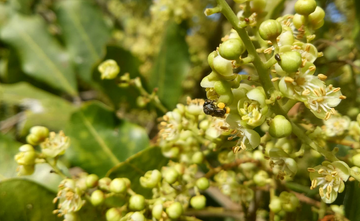
There is a lot of terminology around native bees, which can potentially be confusing for beginners. This article is a breakdown of the most common lingo used within the native bee community.
Species Names
As a whole, these bees are often referred to as stingless bees, bush bees, sugarbag bees, as well as a number of other names. The individual species do not have common names, but beekeepers tend to use simplifications of the scientific names. There are three main species of stingless bees that are kept in Australia:
-
Tetragonula carbonaria - commonly referred to as 'Tc', 'Carbs', or 'Carbonaria'
-
Tetragonula hockingsi - commonly referred to as 'Th', 'Hocks', or 'Hockingsi'
-
Austroplebeia australis - commonly referred to as 'Aa', or 'Australis'
Duplication Methods
Duplication, put simply, is the process of making one hive into two. There are two main ways that native beekeepers duplicate hives.
- Splitting
Boxes made for splitting are made up of two halves, which are stacked on top of each other. Splitting is technique that involves an empty box and a box full of bees. To complete the process, the full hive is split in half, and the top half switched with the top half of the empty box. This means that the beekeeper is left with two, half full bee hives - and in a year or two, the process can be repeated.
- Eduction
Eduction can be completed with a hive of any shape or design. Essentially, a full hive is connected to an empty box via a tube, which forces the bees to travel through the empty box in order to forage. Slowly, the bees build structures inside of the empty box, and eventually get their own queen who lays eggs. At this point, the beekeeper separates the hives and they begin their lives as two seperate colonies. This process can take more than a year.
Both of these processes involve a certain amount of risk, and it is recommended that you do your own individual research, or enlist the help of an expert, before attempting either.
Hive Parts
Brood
Brood is the name for the egg chamber. Typically located in the centre of hives, this is where all bees are laid, pupate, and eventually hatch. In T. carbonaria hives, this is what makes up the distinctive spiral shape.
Advancing Front
This is the edge of the brood that is constantly having new egg cells constructed and laid in. It is always moving within the brood chamber, shifting gradually upwards as new cells are stacked on top of each other. When the advancing front reaches the top of the hive, it will start again at the very bottom, just below the receding edge.
Receding Edge
The receding edge is the opposite of the advancing front. It is where the bees are hatching from their cells, and the cells are being deconstructed to make way for the advancing front.
Queen cells
Queen cells are egg cells that contain a baby queen. They are visibly larger than all other cells. Beekeepers try to identify them, as it indicates that the bees are prepared in case of the death of the reigning queen.
Propolis
Propolis is the material that almost the entire hive is made out of (for most species). It is a mixture of wax (which the bees produce through special glands) and resin (which the bees collect from trees). Also known as cerumen.
Connectives
Connectives are just what they sound like - the thin structures that connect all of the different part of the hive.
Involucrum
An insulating layer of thin propolis that surrounds the brood chamber, particularly in winter or colder climates.
Wax deposits
Wax deposits are small white balls of wax which the bees store connected to honey/pollen pots, or other structures. If they produce more wax than they need in the moment, they will store the excess on one of these balls to use later.
Honey/Pollen pots
These are the generally grape-sized propolis pots where the bees store their honey and pollen.
Honey super
This is a third box that can be added on-top of a native beehive to store and eventually harvest honey in warmer climates.

The Roles of Different Bees
There are a number of different types of bees within a hive, and each has a different role. For more info, see here.
-
Worker - the majority of the population. These are the female bees that do most of the jobs around the hive, such as nursing, construction, foraging, and even fighting.
-
Drone - these are the male bees. They do not forage, fight, or otherwise help out around the hive. Their sole purpose is to attempt to pass on their genetics
-
Queen - the bee that lays all of the eggs in the hive. She is visibly larger than all other bees.
-
Princess - a queen bee that has not mated. There may be a number of these in a hive as well as a the queen, in case anything happens to her.
-
Callow - these bees are simply young bees. They could be any of the above. They are typically a beige colour (which will darken within a day or so).
Related Articles




